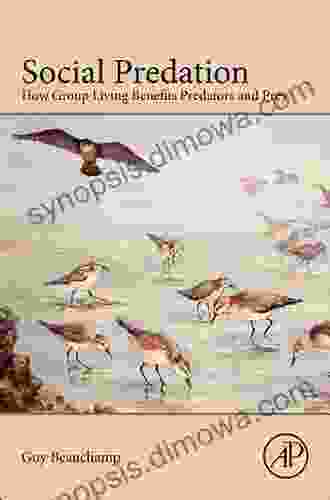How Group Living Benefits Predators and Prey: Exploring the Dynamics of Sociality in the Animal Kingdom

The natural world is a constant dance of life and death, where predators and prey engage in a relentless pursuit. However, within this intricate tapestry of the animal kingdom, a fascinating phenomenon emerges: group living. From lions forming prides to wildebeests herding together, group living has profound implications for both predators and prey, shaping their hunting strategies and defense mechanisms.
Group Living and Predators
For predators, group living offers a multitude of advantages. In a coordinated pack, lions can outmaneuver and subdue prey much larger than any individual lion could tackle alone. Wolves, known for their collaborative hunting prowess, rely on pack members to drive prey towards a central point, increasing their chances of a successful kill.
4.5 out of 5
| Language | : | English |
| File size | : | 2995 KB |
| Text-to-Speech | : | Enabled |
| Screen Reader | : | Supported |
| Enhanced typesetting | : | Enabled |
| Word Wise | : | Enabled |
| Print length | : | 336 pages |
Additionally, group living provides predators with increased vigilance and awareness of their surroundings. With multiple members constantly searching and scanning the environment, the pack can detect potential threats or prey from a distance, maximizing their efficiency and minimizing the risk of being ambushed.
Group Living and Prey
While group living can enhance predators' abilities, it also presents significant challenges for prey animals. However, prey species have evolved remarkable adaptations to counteract these threats. For instance, wildebeests gather in vast herds, forming a collective defense. By staying close together, they make it more difficult for predators to single out and isolate an individual.
In the marine realm, schools of fish exhibit similar behavior. By swimming in synchronized groups, they create a "confusion effect" that disorients predators. The sheer number and erratic movements of the fish make it challenging for predators to focus on a single target, reducing the chances of a successful attack.
Social Structure and Hierarchy
Within predator and prey groups, complex social structures and hierarchies emerge. Among lions, for example, a dominant male leads the pride, controlling access to food and mating rights. This hierarchy ensures that the strongest and most experienced individuals guide the group's decisions and hunting strategies.
In prey species, social hierarchies can serve different purposes. In zebra herds, older and more experienced females often lead the group, guiding their fellow zebras to safe grazing grounds and away from danger. These leaders possess vital knowledge about the terrain and predators, increasing the survival chances of the entire herd.
Evolutionary Implications and Ecosystem Dynamics
Group living in predators and prey has profound evolutionary implications. Over time, species have adapted their social behaviors to maximize their survival and reproductive success. Predators that can form effective groups are more likely to catch prey and pass on their genes. Prey species that can develop efficient defense mechanisms against group predators have a greater chance of survival and reproduction.
Ultimately, group living shapes the dynamics of entire ecosystems. The presence of predator groups can influence the abundance and distribution of prey, while prey group adaptations can affect predator hunting behaviors and populations. These complex interactions create a delicate balance that sustains biodiversity and ecosystem stability.
The world of group living in the animal kingdom is a testament to the incredible diversity and adaptability of life. Predators and prey alike have evolved remarkable social strategies to enhance their chances of survival in the harsh and competitive realm of nature. As we continue to study and unravel the complexities of group living, we gain a deeper appreciation for the interconnectedness of all living things and the beauty of the natural world.
4.5 out of 5
| Language | : | English |
| File size | : | 2995 KB |
| Text-to-Speech | : | Enabled |
| Screen Reader | : | Supported |
| Enhanced typesetting | : | Enabled |
| Word Wise | : | Enabled |
| Print length | : | 336 pages |
Do you want to contribute by writing guest posts on this blog?
Please contact us and send us a resume of previous articles that you have written.
 Book
Book Novel
Novel Page
Page Chapter
Chapter Text
Text Story
Story Genre
Genre Reader
Reader Library
Library Paperback
Paperback E-book
E-book Magazine
Magazine Newspaper
Newspaper Paragraph
Paragraph Sentence
Sentence Bookmark
Bookmark Shelf
Shelf Glossary
Glossary Bibliography
Bibliography Foreword
Foreword Preface
Preface Synopsis
Synopsis Annotation
Annotation Footnote
Footnote Manuscript
Manuscript Scroll
Scroll Codex
Codex Tome
Tome Bestseller
Bestseller Classics
Classics Library card
Library card Narrative
Narrative Biography
Biography Autobiography
Autobiography Memoir
Memoir Reference
Reference Encyclopedia
Encyclopedia David S Lamb
David S Lamb Margreit Maitland
Margreit Maitland Dee Saunders
Dee Saunders Debra Ann Cantrell
Debra Ann Cantrell David Fleminger
David Fleminger Thomas Hall
Thomas Hall Marcia Maxwell
Marcia Maxwell Ie Irodov
Ie Irodov David Gessner
David Gessner Jenny Griffin
Jenny Griffin Richard C Beacham
Richard C Beacham David I Spivak
David I Spivak George Buehler
George Buehler Dee Cannon
Dee Cannon Maya Frost
Maya Frost David Lynn
David Lynn Debra Jason
Debra Jason David Fleming
David Fleming Gavin Thomas
Gavin Thomas Michael Douglas
Michael Douglas
Light bulbAdvertise smarter! Our strategic ad space ensures maximum exposure. Reserve your spot today!

 Victor TurnerUnveil the Enchanting Tapestry of "Chance Encounter" and "Kunoichi Companion...
Victor TurnerUnveil the Enchanting Tapestry of "Chance Encounter" and "Kunoichi Companion...
 Clark CampbellPassing The Multistate Bar Exam Torts: Your Ultimate Guide to Mastering the...
Clark CampbellPassing The Multistate Bar Exam Torts: Your Ultimate Guide to Mastering the...
 Brett SimmonsJourney into the Mythical Depths of "Nessie: The Mannerless Monster" by Ted...
Brett SimmonsJourney into the Mythical Depths of "Nessie: The Mannerless Monster" by Ted... Emanuel BellFollow ·9.7k
Emanuel BellFollow ·9.7k Chuck MitchellFollow ·6k
Chuck MitchellFollow ·6k Austin FordFollow ·2.6k
Austin FordFollow ·2.6k Harry HayesFollow ·15.4k
Harry HayesFollow ·15.4k Ray BlairFollow ·9.9k
Ray BlairFollow ·9.9k William PowellFollow ·8.9k
William PowellFollow ·8.9k Noah BlairFollow ·4.8k
Noah BlairFollow ·4.8k Chris ColemanFollow ·5k
Chris ColemanFollow ·5k

 Aron Cox
Aron CoxMastering Project Management: The Ultimate Guide to...
In today's competitive...

 Dominic Simmons
Dominic SimmonsLet's Build Sue Fliess: Unleash the Polychrome Master...
Chapter 1: The...

 Mason Powell
Mason PowellMaster the Digital Marketing Landscape: Fundamentals of...
In the age of digital...

 Aubrey Blair
Aubrey BlairUncover the Secrets of Ancient Blades and Enchanting...
Embark on an Enchanting Journey into the...

 Shannon Simmons
Shannon SimmonsUnleash the Spooktacular with Spooky Crochet Tutorials...
Prepare to be spooked...

 Cade Simmons
Cade SimmonsImmerse Your Little Ones in a World of Enchantment with...
Nursery rhymes have forever ignited the...
4.5 out of 5
| Language | : | English |
| File size | : | 2995 KB |
| Text-to-Speech | : | Enabled |
| Screen Reader | : | Supported |
| Enhanced typesetting | : | Enabled |
| Word Wise | : | Enabled |
| Print length | : | 336 pages |






